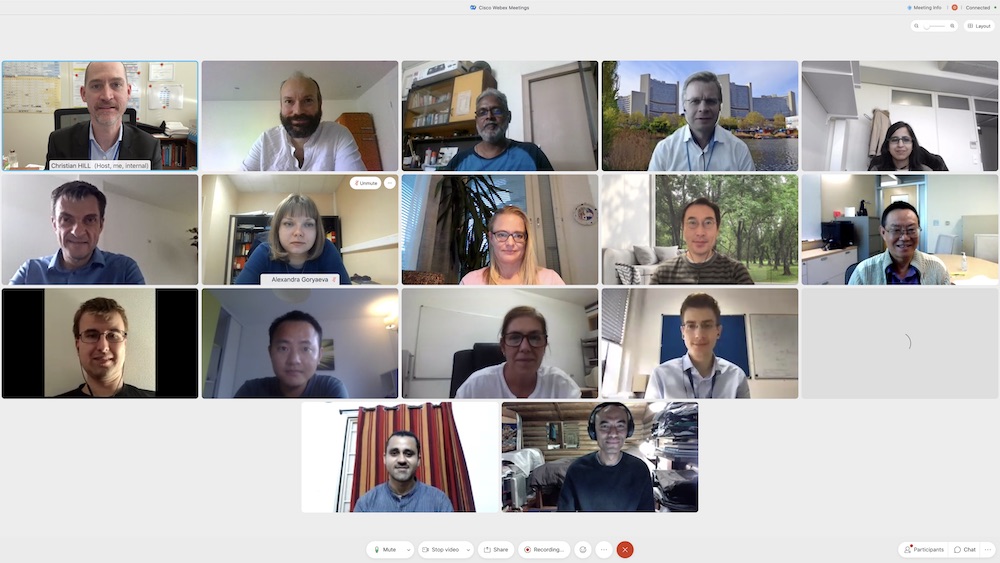7th Meeting of the CCN
The 7th biennial meeting of the Code Centres Network was held virtually from 18 – 20 October 2021. The Scientific Secretary is Christian Hill (Unit Head, Atomic and Molecular Data Unit, IAEA).
The meeting focuses on computational simulations of radiation damage in nuclear materials, particularly (1) collisional cascade simulations of neutron-irradiated fusion reactor materials and (2) density functional theory calculations of the energetics, evolution and properties of radiation-induced defects in such materials.
The IAEA maintains two databases relevant to this research: CascadesDB and DefectDB. Their development and population relies on efforts by research groups who participate in the Code Centres Network, coordinated by meetings such as this one, which set priorities, evaluate and recommend data, and identify data needs.
In addition to reviewing recent research in cascade simulation and DFT studies of defects, the issue of high-dose (several displacements per atom) damage (in fission reactors as well as candidates for experimental controlled fusion devices) was addressed, and the scope for the use of CascadesDB and DefectDB within the multiscale modelling workflows of the ENTENTE (European Database for Multiscale Modelling of Radiation Damage) project assessed.

Agenda
Monday, 18 October 2021
| 14:00 – 14:30 | Melissa DENECKE (DIR-NAPC), Arjan KONING (SH-NDS), Christian HILL (UH, AMD Unit): Welcome, introduction of the participants, adoption of the agenda |
| 14:30 – 15:00 | Marta SERRANO (Centro de Investigaciones Energeticas, Medioambientales y Tecnologicas, Spain) Status of the ENTENTE database, Sept 2020 – Oct 2021 |
| 15:00 – 15:30 | Andrea SAND (Aalto University, Finland) Electronic energy losses in collision cascade simulations [abstract (pdf)] |
| 15:30 – 15:50 | Virtual Coffee Break |
| 15:50 – 16:20 | Fei GAO (Department of Nuclear Engineering and Radiological Science, University of Michigan, United States of America) Radiation Resistance in Multicomponent Equiatomic Alloys [abstract (pdf)] |
| 16:20 – 16:50 | Wahyu SETYAWAN (Pacific Northwest National Laboratory, United States of America) Cascade simulations in W-Ni-Fe heavy alloys and DFT study of He interaction with transmutation solutes in nano ferritic alloys [abstract (pdf)] |
Tuesday, 19 October 2021
| 14:00 – 14:30 | Huiqiu DENG (Hunan University, China) Interatomic potentials and displacement cascade simulations for W and W-based alloys [abstract (pdf)] |
| 14:30 – 15:00 | Christophe DOMAIN (EDF R&D Lab Les Renardières, France) Statistical analysis of displacement cascades in Fe, W and Ni ; solute segregation at grain boundaries in Fe |
| 15:00 – 15:20 | Virtual Coffee Break |
| 15:20 – 15:50 | Christian HILL (IAEA) The IAEA CascadesDB and DefectDB databases |
| 15:50 – 16:20 | Utkarsh BHARDWAJ (Computational Analysis Division, Bhabha Atomic Research Centre, India) Integration of CSaransh with CascadesDB [abstract (pdf)] |
| 16:20 – 16:50 | Manoj Kumar WARRIER (Computational Analysis Division, Bhabha Atomic Research Centre, India) Defect Cluster Classification, Morphology and Stability Studies from Molecular Dynamics Simulations of Collision Cascades [abstract (pdf)] With Utkarsh BHARDWAJ |
Wednesday, 20 October 2021
| 14:00 – 14:30 | María J. CATURLA (Department of Applied Physics, University of Alicante, Spain) Collision cascades in the presence of dislocations [abstract (pdf)] |
| 14:30 – 15:00 | Alexandra GORYAEVA ((CEA Saclay), France) Machine learning for atomistic materials science [abstract (pdf)] with Mihai Cosmin MĂRINICĂ |
| 15:00 – 15:30 | Jiting TIAN (Institute of Nuclear Physics and Chemistry (CAEP), China) Computational studies of high-dose radiation damage in hcp Zirconium [abstract (pdf)] |
| 15:30 – 15:50 | Virtual Coffee Break |
| 15:50 – 16:20 | Daniel MASON (United Kingdom Atomic Energy Authority, United Kingdom) Simulated irradiation in the high-dose limit [abstract (pdf)] |
| 16:20 – 17:00 | Discussion (all participants) |
Participants
21 participants from 8 countries.
Presentations
Utkarsh BHARDWAJ (Computational Analysis Division, Bhabha Atomic Research Centre, India)
Integration of CSaransh with CascadesDB
[abstract (pdf)]
María J. CATURLA (Department of Applied Physics, University of Alicante, Spain)
Collision cascades in the presence of dislocations
[abstract (pdf)]
Huiqiu DENG (Hunan University, China)
Interatomic potentials and displacement cascade simulations for W and W-based alloys
[abstract (pdf)]
Christophe DOMAIN (EDF R&D Lab Les Renardières, France)
Statistical analysis of displacement cascades in Fe, W and Ni ; solute segregation at grain boundaries in Fe
Fei GAO (Department of Nuclear Engineering and Radiological Science, University of Michigan, United States of America)
Radiation Resistance in Multicomponent Equiatomic Alloys
[abstract (pdf)]
Alexandra GORYAEVA ((CEA Saclay), France)
Machine learning for atomistic materials science
[abstract (pdf)]
with Mihai Cosmin MĂRINICĂ
Christian HILL (IAEA)
The IAEA CascadesDB and DefectDB databases
Daniel MASON (United Kingdom Atomic Energy Authority, United Kingdom)
Simulated irradiation in the high-dose limit
[abstract (pdf)]
Andrea SAND (Aalto University, Finland)
Electronic energy losses in collision cascade simulations
[abstract (pdf)]
Marta SERRANO (Centro de Investigaciones Energeticas, Medioambientales y Tecnologicas, Spain)
Status of the ENTENTE database, Sept 2020 – Oct 2021
Wahyu SETYAWAN (Pacific Northwest National Laboratory, United States of America)
Cascade simulations in W-Ni-Fe heavy alloys and DFT study of He interaction with transmutation solutes in nano ferritic alloys
[abstract (pdf)]
Jiting TIAN (Institute of Nuclear Physics and Chemistry (CAEP), China)
Computational studies of high-dose radiation damage in hcp Zirconium
[abstract (pdf)]
Manoj Kumar WARRIER (Computational Analysis Division, Bhabha Atomic Research Centre, India)
Defect Cluster Classification, Morphology and Stability Studies from Molecular Dynamics Simulations of Collision Cascades
[abstract (pdf)]
With Utkarsh BHARDWAJ